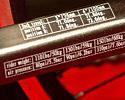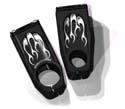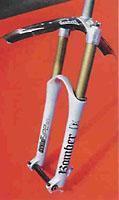
Recently on Cyclingnews.com |
Tech update – November 9, 2002
Edited by Paul Mirtschin
Got tech? Send press releases, news, and tech questions to the Cyclingnews tech-heads.
A Tirade from K2
 |
With almost every mountain bike manufacturer rolling out an adjustable travel "freeride" bike, it is not surprising that K2 has rolled out one themselves. Called the Tirade, this new model range features an adjustable four to six inch travel rear, and in a first for K2, doesn't actually use their in-house brand of suspension, Noleen, as previous bikes have, but comes equipped with Fox Racing Shox on both ends. The frame has one of the beefiest front ends we have seen, while the intersection of the seat-tube and rocker arm looks almost frail in comparison. Only some hard time in the wild will show if it's up to the job.
 |
One funky addition to the air sprung models is a table of suggested air pressures on the chain stays. No longer will you be rooting around the workshop trying to find where you stashed the printed table.
Like a lot of "freeride" manufacturers, K2 are equipping the Tirade with a OnePointFive headtube to allow the use of this new "standard". But with only one fork manufacturer using the standard at the moment, it's too early to tell if the standard will stay.
OnePointFive and steady
 |
It happens every few years, a component manufacturer decides that the current line of thinking isn't cutting it, and that they have a better way. Sometimes they are right, sometimes not. And depending on what camp you sit in, the OnePointFive headtube standard is either a much needed step forward in suspension, or a huge waste of time. The original idea came from the collective of Answer/Manitou, Cane Creek Components, King Cycle Group, Race Face Components and Rocky Mountain Bicycles. They decided that five inches of travel was the limit of a normal single crown suspension fork, and that if you wanted more travel (but not the hassle of triple clamp forks) then the only option was to move up to a 1.5 inch steerer tube.
Fine, except a bigger steerer tube needs a frame it will fit into, and unless you own a Cannondale (and more on that later) that means a new frame. So from the start, this is a standard that won't take off overnight, or will it?
 |
It seems that most companies are testing the water, by either releasing a range of bikes complete with one of the three individual forks on offer, or by releasing frames with reducer cups and standard forks. Now this is something that Cannondale owners have had offered to them for a while, allowing the use of 1.125 inch steerer forks in a frame built for a Headshock. However, don't go thinking you can slap a 1.5 fork into your old 'dale. Cannondale have this to say on the matter, "Cannondale HeadShok forks have always used a steerer diameter very close to the OnePointFive standard and large diameter head tubes. The OnePointFive system will "plug into" all Gemini frames, but not other Cannondale frames as of now because the insertion press dimension of the new OnePointFive headsets to the frame may be as much as twice that of standard headsets i.e. the headset won't go into the frame all the way."
 |
So now, the customer doesn't need to spend big all at once. New frame now, new 1.5 forks later. And with more than 25 frame manufacturers offering frames you are sure to find one that you like. However, when it comes to forks… well you are still looking at a range of three.
Most of the fork manufacturers are quite happy stopping at five inches for a single crown, and why not, if you want more, then you can buy their triple clamp fork. And just to prove a point, Marzocchi went and made a six inch travel single crown that uses the 1.125 current standard.
So where are we at? Will onepointfive still be here in five years time? Probably. But so will the current 1.125 standard, because after all, you can't have too many standards. Should you run out and buy the 1.5 frame and fork? If you are looking for a new bike, then sure, as you can always use a reducer cup if they stop making the forks.
Flying saucer - a cranking invention
 |
We recently had a visit from Peter Bortolin, an Australian inventor who has developed a new idea on how to get the most power to the rear wheels of a track bike. Now the idea of elliptical pedal strokes isn't a new one, but this implementation certainly looks different. With this mechanism, Bortolin claims as much as a 50% greater mechanical efficiency is achievable than with the conventional bicycle mechanism. Check out the the pictures and see.
Photos
Images by respective photographers
- Manitou's 6" 1.5 standard Sherman fork, and its 5" travel 1.125" Black
- Detail shot of the Flying Saucer cranks
- Drive side view of the cranks fitted
- Non-drive side view of the cranks
- 1.5" and 1.125" stems from RaceFace
- Never look for the pressure charts again
- The K2 Tirade in all its glory
- The rocker link showing the three suspension settings
Recent techTour tech: Zipp's slippery
new wheel revealed |
